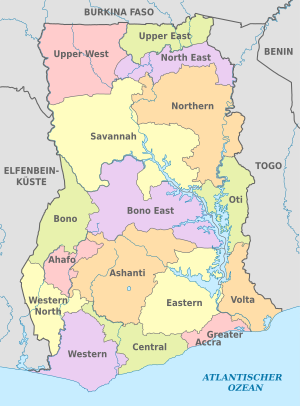Regions_of_Ghana
Regions of Ghana
16 principal administrative areas of the republic in West Africa
The regions of Ghana are the first level of subnational government administration within the Republic of Ghana. As of 2020, there are 16 regions,[1] which are further divided for administrative purposes into 260 local metropolitan, municipal and district assemblies (or MMDA's).
| Regions of Ghana | |
|---|---|
 | |
| Location | Republic of Ghana |
| Number | 16 Regions |
| Subdivisions | |
The ten former regions were officially established in 1987, when the Upper West Region was inaugurated as the state's newest administrative region, although it had already functioned as an administrative unit since the break-up of the Upper Region in December 1982, prior to the 1984 national census.[2] A referendum on the creation of six new regions was held on 27 December 2018, where all proposed new regions were approved.[3]
Independence - 6 March 1957
At independence in March 1957, the Northern Territories, Trans-Volta Togoland and the Gold Coast came together to form Ghana. There were initially five regions. The Trans-Volta Togoland was combined with part of the Eastern Region and Northern Territories to form the Volta Region.
| Former region | Capital | New region | Capital |
|---|---|---|---|
| Ashanti Protectorate | Kumasi | Ashanti Region | Kumasi |
| Eastern Province | Koforidua | Eastern Region | Koforidua |
| (Keta) | Volta Region | Ho | |
| Trans-Volta Togoland | Ho | ||
| Northern Territories | (Saboba) | ||
| Tamale | Northern Region | Tamale | |
| Western Province | Sekondi | Western Region | Sekondi |
Post-independence and First Republic
On 4 April 1959, the Ashanti Region was split into the Ashanti and Brong-Ahafo regions as a result of the Brong Ahafo Region Act No. 18 of 1959.[7] This was in line with what the Brong Kyempem movement had been campaigning for, which was the recognition of the Bono people as a separate ethnic group from the Ashantis with their own region.[5]
On the day Ghana became a republic, 1 July 1960, the Northern Region got split into the Northern and Upper regions raising the number of regions to seven.[5][7]
| Former region | Capital | New region | Capital |
|---|---|---|---|
| Ashanti | Kumasi | Ashanti | Kumasi |
| Brong-Ahafo Region | Sunyani | ||
| Eastern Region | Koforidua | Eastern Region | Koforidua |
| Northern Region | Tamale | Northern Region | Tamale |
| Upper Region | Bolgatanga | ||
| Volta Region | Ho | Volta Region | Ho |
| Western Region | Sekondi | Western Region | Sekondi |
Second Republic
During the Second Republic, the Western Region was split into the Western and Central regions, making eight regions in total. This was done ahead of the 1970 census. In 1971, Sekondi and Takoradi were merged to form Sekondi-Takoradi, the new capital of the Western Region.[5][6]
| Former region | Capital | New region | Capital |
|---|---|---|---|
| Ashanti | Kumasi | Ashanti | Kumasi |
| Brong-Ahafo region | Sunyani | Brong-Ahafo region | Sunyani |
| Eastern Region | Koforidua | Eastern Region | Koforidua |
| Northern Region | Tamale | Northern Region | Tamale |
| Upper Region | Bolgatanga | Upper Region | Bolgatanga |
| Volta Region | Ho | Volta Region | Ho |
| Western Region | Sekondi | Western Region | Sekondi-Takoradi |
| Central Region | Cape Coast | ||
PNDC era
The Provisional National Defence Council, which was the military government in power between 1981 and 1993, promulgated the Greater Accra Law (PNDCL 26) of 23 July 1982 which created the Greater Accra Region. The new region consisted of the Accra Capital District and the Ada Local Council, which were split off from the Eastern Region. In the following year 1983, the Upper Region was divided into the Upper East Region and Upper West Region, bringing the total number of regions to ten.[6][7]
- List of Ghanaian regional ministers
- List of Ghanaian regions by area
- List of Ghanaian regions by Human Development Index
- List of Ghanaian regions by population
- ISO 3166-2:GH
General:
- "Ghana Now Has 16 Regions". Modern Ghana.
- David Owusu-Ansah. Historical Dictionary of Ghana (4 ed.). Rowman & Littlefield. p. xii.
- Zurek, Kweku. "CONFIRMED: Results of the 2018 Referendum on new regions". Graphic Online. Retrieved 28 December 2018.
- "Sefwi Wiaso is capital of Western North region". www.myjoyonline.com.
- Vinorkor, Mark-Anthony (5 March 2020). "Evolution of the regions: from 5 to 16". Graphic Online. Graphic Communications Group Ltd. Retrieved 21 October 2020.
- "Regions of Ghana". statoids.com. Gwillim Law and Shirley Law. 2018. Retrieved 21 October 2020.
- "A short history of the creation of regions in Ghana". ghanaweb.com. GhanaWeb. 23 January 2019. Retrieved 24 October 2020.
